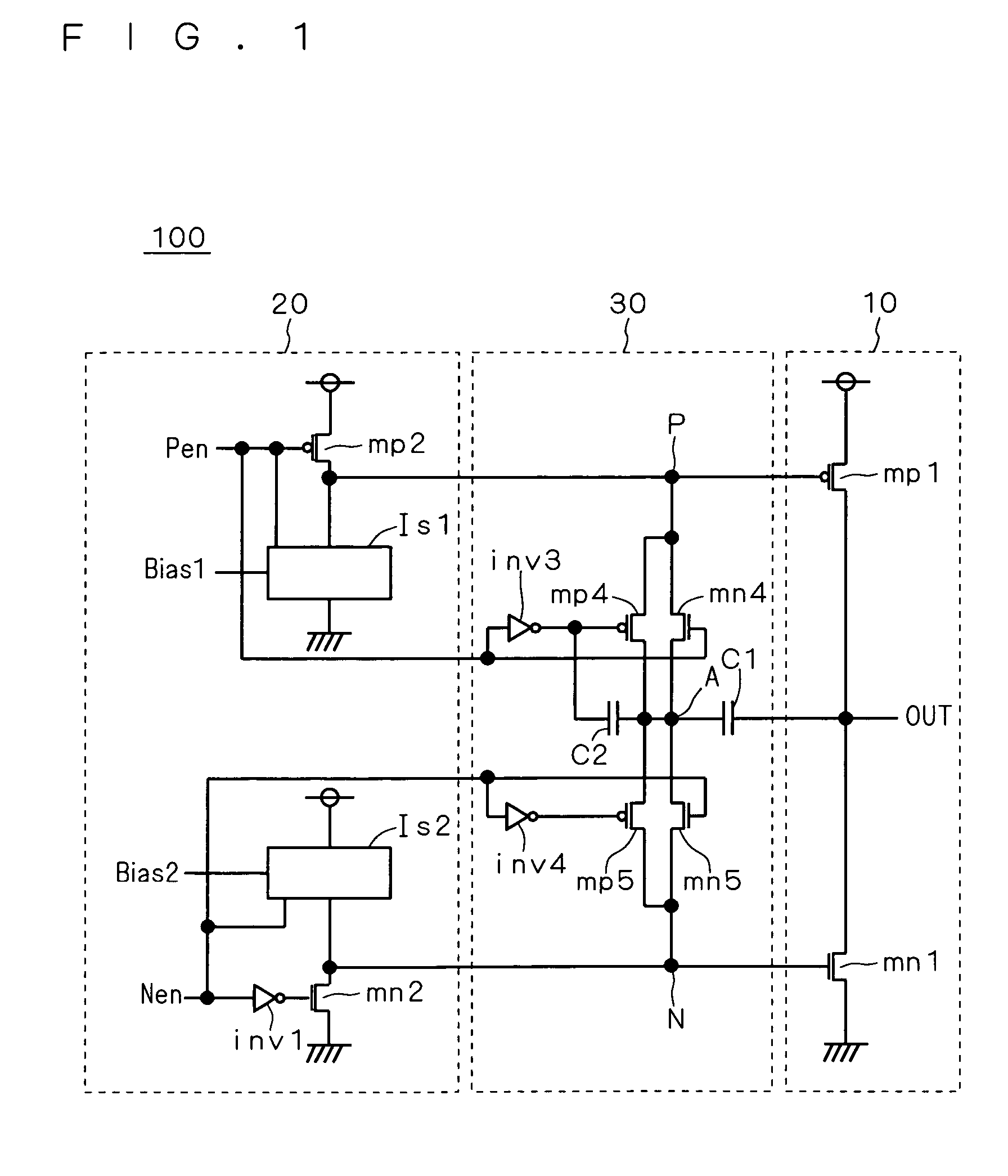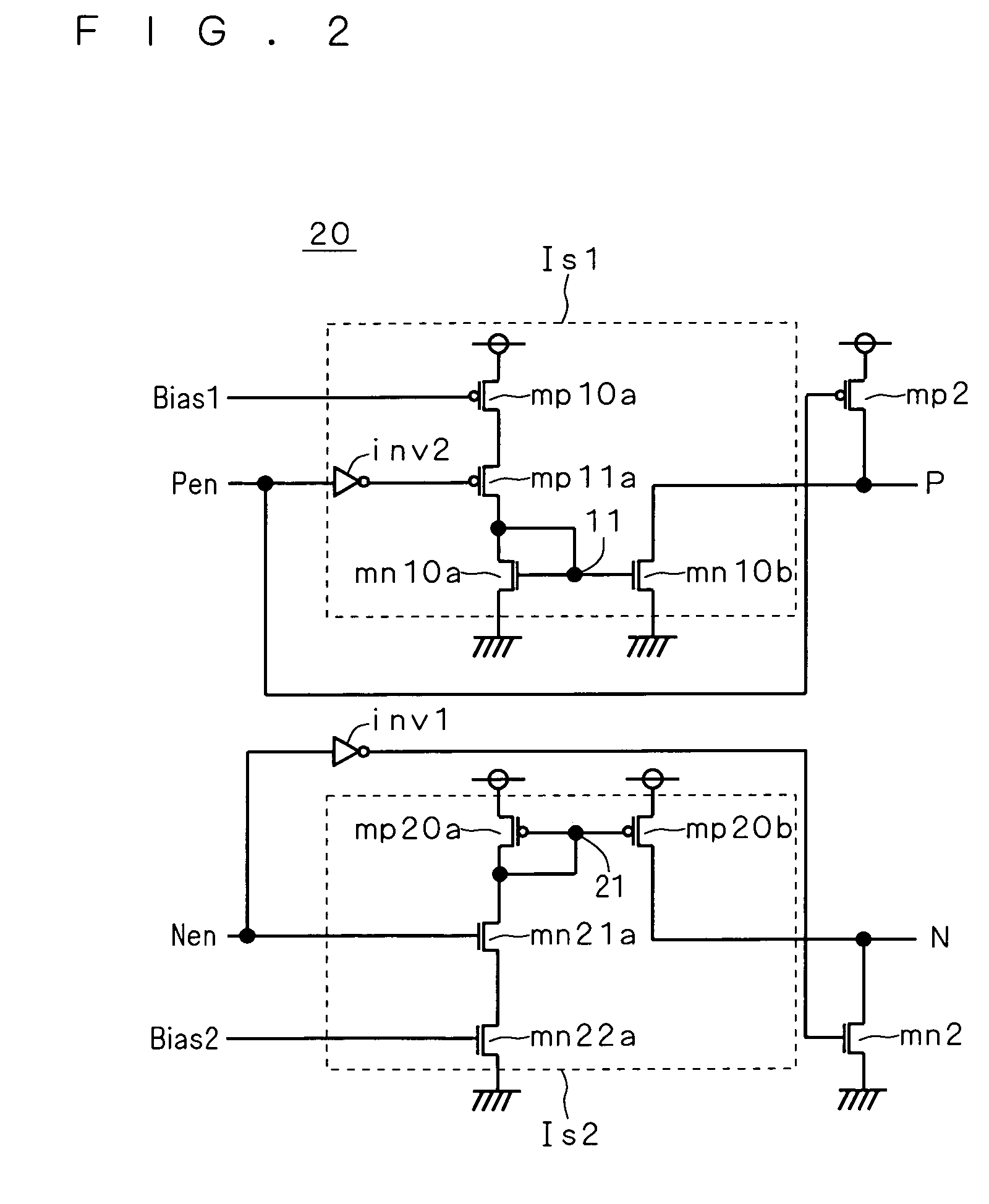Output buffer circuit
a buffer circuit and output technology, applied in the field of output buffer circuits, can solve the problems of change in output delay and increase in delay, and achieve the effect of reducing output delay
- Summary
- Abstract
- Description
- Claims
- Application Information
AI Technical Summary
Benefits of technology
Problems solved by technology
Method used
Image
Examples
first preferred embodiment
[0030]FIG. 1 shows a circuit diagram of the structure of a slew-rate controlled output buffer circuit 100 according to a first preferred embodiment. As shown, the output buffer circuit 100 includes a driver circuit 10, a driver control circuit 20 for controlling the driver circuit 10, and a capacitor circuit 30 interposed between the driver circuit 10 and the driver control circuit 20 for controlling a slew rate. FIG. 2 shows a circuit diagram of a detailed structure of the driver control circuit 20 shown in FIG. 1.
[0031]As shown in FIG. 1, the driver circuit 10 includes a PMOS transistor mp1 and an NMOS transistor mn1. The driver control circuit 20 includes constant current sources Is1 and Is2, a PMOS transistor mp2, an NMOS transistor mn2, and an inverter inv1. The capacitor circuit 30 includes capacitors C1 and C2, inverters inv3 and inv4, PMOS transistors mp4 and mp5, and NMOS transistors mn4 and mn5.
[0032]As shown in FIG. 2, the constant current source Is1 includes PMOS transis...
second preferred embodiment
[0069]In the output buffer circuit 100 shown in FIG. 1 according to the first preferred embodiment, the capacitors C1 and C2 are not connected to the node P or the node N at all times. It is therefore required that the node N be fixed to an H level (namely, the node A be fixed to an H level) when the signal Pen is switched from an L level to an H level and the signal Nen from an H level to an L level, for example. Accordingly, when the signals Pen and Nen have high frequencies, the potential of the node N cannot follow the switching of the signals Pen and Nen before being fixed to an H level, which may result in a variation in delay value.
[0070]FIG. 6 shows a circuit diagram of the structure of a slew-rate controlled output buffer circuit 100a according to a second preferred embodiment. FIG. 6 includes a capacitor circuit 30a instead of the capacitor circuit 30 shown in FIG. 1. The capacitor circuit 30a includes capacitors CP1, CP2, CN1, CN2, and an inverter inv5.
[0071]In the capaci...
third preferred embodiment
[0084]In the output buffer circuit 100a shown in FIG. 6 according to the second preferred embodiment, the capacitors CP2 and CN2 are out of contact with the node OUT, and are thus not used for slew rate control. Alternatively, the capacitors CP2 and CN2 may be disposed to come into contact with the node OUT, to be used for slew rate control.
[0085]FIG. 7 shows a circuit diagram of the structure of a slew-rate controlled output buffer circuit 100b according to a third preferred embodiment. FIG. 7 includes a capacitor circuit 30b instead of the capacitor circuit 30 shown in FIG. 1. The capacitor circuit 30b includes the capacitors CP1, CP2, CN1, CN2, the inverter inv5, PMOS transistors mp6 and mp7, and NMOS transistors mn6 and mn7.
[0086]In the capacitor circuit 30b, the respective one ends of the capacitors CP1, CP2, CN1, and CN2 are connected to each other at the node OUT. The other end of the capacitor CP1 is connected at the node P to the gate of the PMOS transistor mp1, the drain o...
PUM
 Login to View More
Login to View More Abstract
Description
Claims
Application Information
 Login to View More
Login to View More - R&D
- Intellectual Property
- Life Sciences
- Materials
- Tech Scout
- Unparalleled Data Quality
- Higher Quality Content
- 60% Fewer Hallucinations
Browse by: Latest US Patents, China's latest patents, Technical Efficacy Thesaurus, Application Domain, Technology Topic, Popular Technical Reports.
© 2025 PatSnap. All rights reserved.Legal|Privacy policy|Modern Slavery Act Transparency Statement|Sitemap|About US| Contact US: help@patsnap.com



